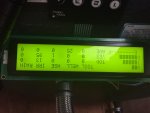Looking for some help on using 40 meters of Cat5 twisted pair with I2c (slow), with 3 nodes. I have both the P82B715 extenders, as well as the alternate P82B96 units as well. What will be hooked up I2C wise:
Node1: 40x2, clock, eeprom, lcd, P82B715 (total capacitance = 50pf)
10 meters away, node 2: 20x2, P82B715 (total capacitance 20pf)
30 meters away from node 2, node3: 40x2, digital POT, P82B715 (total capacitance 30pf)
cable capacitance would be about 2,000 pf at 50pf/lin meter at 100khz.
I have nodes 1 and 3 communicatiing now using the 715's, but I am getting some I2C transmission errors (data values of 255) that I would like to deal with.
I am using 4.7K pullups on the pic side at each of the two ends, I think I have two 270 ohms pullups on the bus side at the moment to get things 'going', but I want to select the proper resisters to fit my situation.
I have been using this document from nxp, which discusses in detail both chip options: http://www.nxp.com/documents/data_sheet/P82B715.pdf
It looks like 4.7k pullups on each of the three node's (pic side, one on each line), and 3 - 750 ohm pullups on the bus side (which result in a net bus pullup resistance of 250 ohms) should meet the I2c Bus and maximum current draw specification on the 715's.
So two questions for anyone familiar with this stuff:
1. Am I OK with the resistance values as stated (I am effectively building the circuuit diagram shown in figure 6 of the pdf)?
and
2. Would I be better off using the P82B96, and driving the bus side at say 12 volts?
Thanks in advance!!
John
Node1: 40x2, clock, eeprom, lcd, P82B715 (total capacitance = 50pf)
10 meters away, node 2: 20x2, P82B715 (total capacitance 20pf)
30 meters away from node 2, node3: 40x2, digital POT, P82B715 (total capacitance 30pf)
cable capacitance would be about 2,000 pf at 50pf/lin meter at 100khz.
I have nodes 1 and 3 communicatiing now using the 715's, but I am getting some I2C transmission errors (data values of 255) that I would like to deal with.
I am using 4.7K pullups on the pic side at each of the two ends, I think I have two 270 ohms pullups on the bus side at the moment to get things 'going', but I want to select the proper resisters to fit my situation.
I have been using this document from nxp, which discusses in detail both chip options: http://www.nxp.com/documents/data_sheet/P82B715.pdf
It looks like 4.7k pullups on each of the three node's (pic side, one on each line), and 3 - 750 ohm pullups on the bus side (which result in a net bus pullup resistance of 250 ohms) should meet the I2c Bus and maximum current draw specification on the 715's.
So two questions for anyone familiar with this stuff:
1. Am I OK with the resistance values as stated (I am effectively building the circuuit diagram shown in figure 6 of the pdf)?
and
2. Would I be better off using the P82B96, and driving the bus side at say 12 volts?
Thanks in advance!!
John

